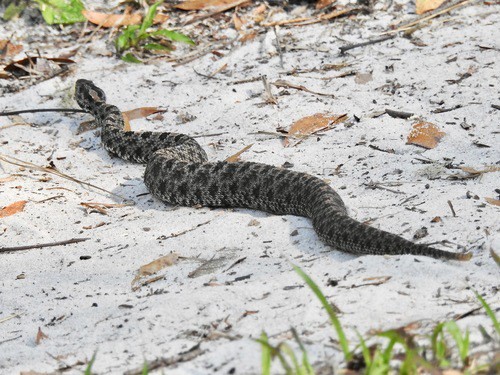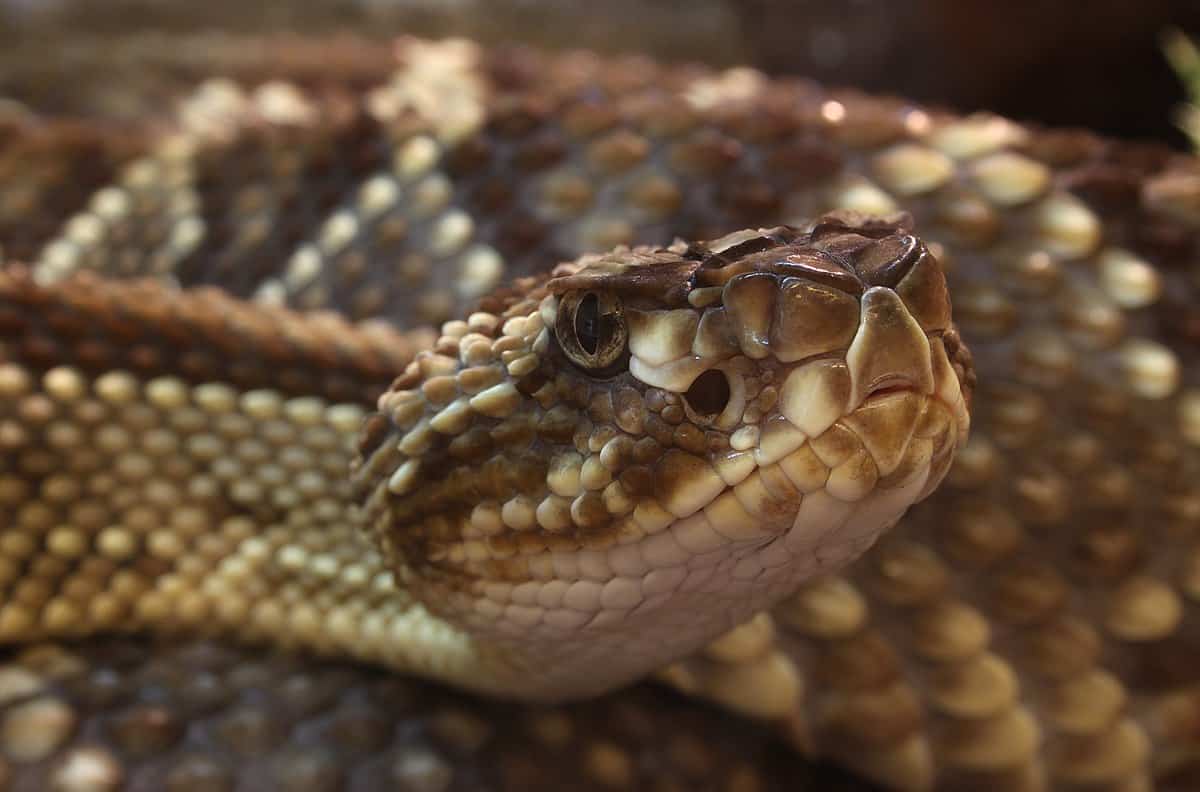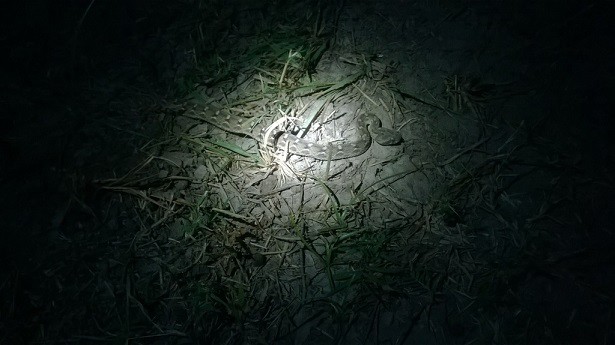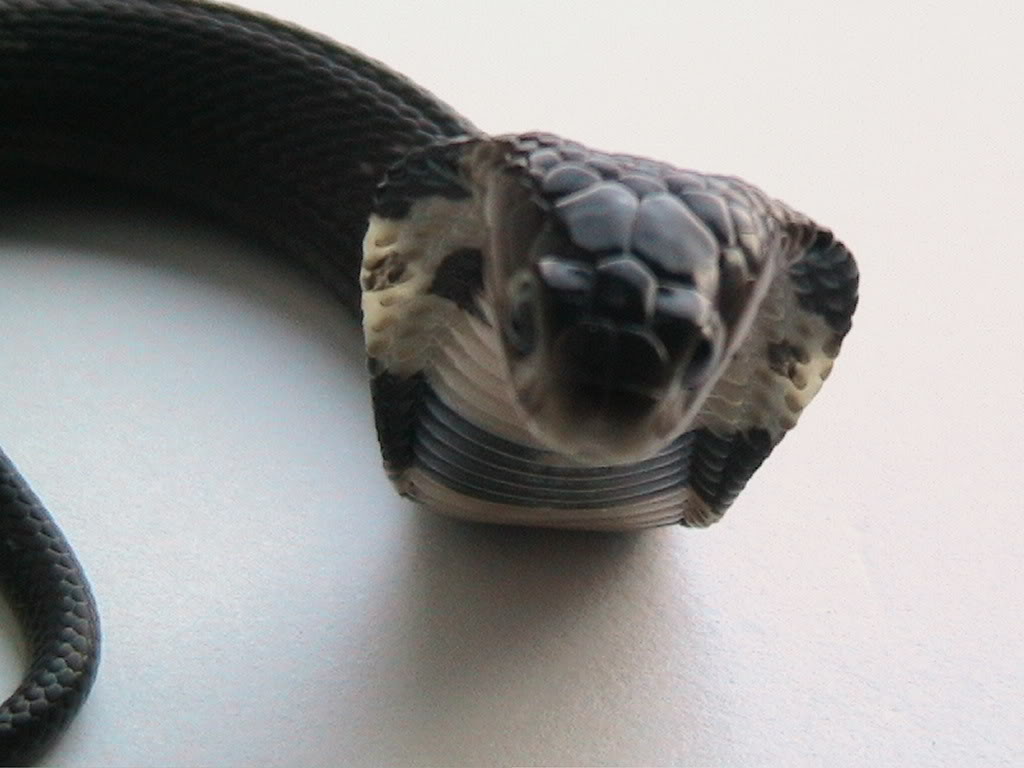| 1 | Jararaca: Captopril |

The most successful drug made from snake venom. The jararaca lives in southeast Brazil, particularly the outskirts of Rio de Janeiro. It causes 52% of snakebites in some areas, and can cause kidney damage, serious necrosis and incoagulable blood. But more recently, its venom has been saving people.
Angiotensin-II is a compound in the bloodstream which causes blood vessels to constrict, which is generated by a series of reactions from its less powerful cousin, angiotensin-I. Back in the 1970s, scientists Sérgio Henrique Ferreira and John Vane injected peptides from jararaca venom into dogs, and realised that its blood pressure lowering properties worked by blocking angiotensin-converting enzymes. Ordinarily, this is fatal, but after making a few tweaks, they created a new molecule: captopril.
Captopril was officially launched in 1981. It remained a popular drug for years, and snake venom made it possible, forged over millions of years in the forests of Brazil. Captopril had moderate side effects such as coughs, rashes and taste disturbances, so it was eventually replaced by similar drugs with a tweaked molecular structure, but ultimately based on the original goodness donated by the snake world. Captopril has FDA approval to this day.
| 2 | Malaysian blue coral snake |

Malaysian blue coral snakes are a hard snake to miss, with their electric blue body and red head. Their venom is neurotoxic, yet features the ingredient calliotoxin, which is completely unique in the snake kingdom. Most paralysing snakes act by blocking brain signals, usually filling acetylcholine receptors in muscle cells, as with black mambas.
Calliotoxin is a little different: it overexcites sodium channels, causing what’s called “spastic paralysis”, rather than flaccid paralysis. Sodium channels normally receive nerve signals, but their gateways remain permanently open, meaning that they never “cool off”. The result is hyperactivity, which allows Malaysian blue coral snake venom to paralyse its victims within minutes, or seconds.
Scientists are interested in this venom because hyperactive sodium channels are a huge cause of chronic pain. Fentanyl acts via the opioid pathway while paracetamol is a standard anti-inflammatory painkiller. Mass market painkillers that rely on the more subtle sodium channel method are barely available, and scientists are particularly keen on investigating calliotoxin. Right now, calliotoxin overexcites sodium channels, but with a few molecular tweaks, its possible that scientists can create the reverse. This species is most common in Thailand and mainly lives in moist forests.
| 3 | Pygmy rattlesnake: Eptifibatide |

The dusky pygmy rattlesnake is a subspecies found in the woods of Florida. It has signature darker colours, with more rounded blotches, and reaches a maximum of 62cm. No deaths have been recorded from this rattlesnake, but its venom causes nasty swelling and serious haemorrhaging.
Chief among its toxins is the barbourins, which disable blood clotting by preventing platelets from sticking together. Specifically, this targets the GP IIb/IIIa receptor, which combines with fibrinogen at a late stage to finally create a finished clot. The story started in 1991, when a study scanned 52 toxins found in snake species. Many blocked the GP IIb/IIIa receptor, but only one targeted it selectively: barbourins found in dusky pygmy rattlesnakes. Scientists knew they were on to something, and tweaked the molecular structure of barbourin to create eptifibatide. Instead of hospitalisation, this had the nobler goal of reducing blood clots in heart disease and stroke patients.
Eptifibatide was approved by the FDA in 1998. Nobody was squeamish about its origin in a venomous rattlesnake (nobody who admitted it anyway). Eptifibatide has several advantages, as the antiplatelet powers not only activate rapidly, but cease rapidly when the injection of the molecule is stopped. A previous GP IIb/IIIa blocking medication was abciximab, but this went wrong due to its long half life. Today, this serpentine molecule is mainly used as an emergency medication.
| 4 | South American rattlesnake |

This molecule hasn’t been approved yet, but scientists around the world have their eyes keenly fixed on it. Collinein-1 is found in the venom of the South American rattlesnake (Crotalus durissus), an extremely widespread species ranging from Guatemala to southern Brazil.
This rattlesnake specialises in neurotoxic symptoms, like paralysis, slurred words and lungs that refuse to inflate. But the usual rattlesnake haemorrhaging also happens, just at more moderate levels. Collinein-1 is one such haemorrhagin, and is much more basic than Echistatin, simply consuming fibrogenin, the physical building block of blood clots. This causes free bleeding at the rattlesnake bite mark, but potentially from the eyes and gums too.
In a 2021 study, scientists modified this molecule to create PEG-rCollinein-1, a version bound with propylene glycol. This is a process used on 19 approved medications so far. It’s designed to increase a molecule’s stability in the bloodstream, making it more resistant to immune system assaults. This kept collinein-1 active in the body for longer, increasing the time between doses if it ever became a real medication. Scientists believed that this rattlesnake molecule was a great candidate for dissolving stubborn blood clots in heart disease patients, and planned to investigate further.
| 5 | Saw-scaled viper: Tirofabin |

A snake-derived drug approved by the FDA in 1998. Tirofiban was created from Echistatin, found in the venom of India’s saw-scaled viper, part of the “big 4” of India’s deadliest snakes. It’s an antiplatelet medication used to prevent fatal blood clots in heart disease and stroke patients, saving lives despite its deadly origins. Saw-scaled vipers are famed for their haemorrhaging, and cause uncontrollable bleeding more commonly than their Indian cobra neighbour. They prefer drier areas of India, lurking in holes in semi-deserts, or hiding in piles of coconut husks.
Echistatin is a disintegrin, which cases haemorrhaging in combination with metalloproteinases. Echistatin works similarly to eptifibatide from dusky rattlesnakes. In the final stage of healthy blood clot formation, after dozens of substeps, fibrinogen binds with αIIBβ3 integrin. Echistatin competes with fibrinogen for this binding, preventing the clot from forming.
In a bite in the dusty countryside of India, this can be and is fatal. Saw-scaled vipers have killed hundreds or even thousands of Indians since the year 2000. But with a few tweaks to echistatin, scientists created Tirofiban, and a useful drug to keep heart disease patients alive and happy for many more years.
| 6 | Venom: the new life hack |

This story has nothing do with science, or at least science that we’re aware of. The protagonist was Steve Ludwin, aged 50, who had been injecting himself with snake venom every day for the last 28 years. Ludwin was a musician, the lead singer in a punk rock band, and was pictured with a green snake curled around his neck. He claimed that thanks to a daily venom dose, he hadn’t had a cold or flu in 13 years.
Ludwin was a keen tennis player, and claimed that by injecting cobra or rattlesnake venom 1 hour earlier, his performance went through the roof, making him feel like a 23 year old again. ‘I don’t deny it’s cheating, but when you’re 50, having such energy can feel quite surreal”, he said. It wasn’t nonsense though, as Ludwin was now working with scientists from the University of Copenhagen. Daily venom injections had apparently built up a healthy immunity.
Ludwin was the owner of 18 snakes, and has even gargled snake venom. He was a renowned expert in the field of snake milking, placing snake on clingfilm stretched over a shot glass in the precise manner that forces it to release its yellowish venom.
| 7 | Ximelagatran (cobras) |

A medication that went wrong at the last minute. Ximelagatran was touted as a replacement for the popular blood thinner warfarin. Given that warfarin is a rat poison, this replacement fit well in that it was discovered in cobra (Naja family) venom. Ximelagatran is a cobra’s thrombin shredder, destroying a chief blood clotting agent so that prey such as rodents bleed to death before they can dart away. Ximelagatran was found to be highly effective against deep vein thrombosis in patients, and had the advantage of being taken orally twice daily, unlike other thrombin inhibitors.
Ximelagatran actually gained approval in Germany, Portugal, Finland and Norway. It only fell at the last minute due to human safety studies, where 5-6% showed elevated liver enzymes. Likewise, warfarin has an easy antidote in case excessive bleeding kicks in, whereas a simple antidote for ximelagatran wasn’t forthcoming.
Concerns for hepatotoxicity led to the FDA rejecting this cobra molecule in 2004. In 2006, AstraZeneca withdrew the supply of ximelagatran even from countries where it had been approved. Many of these molecules have been successful, but it’s best not to get overconfident and forget where they came from: a venomous snake.
| 8 | The secrets of crotamine |

Crotamine is a myotoxin, a muscle shredding peptide with moderate necrotic dangers. It’s mainly found in South American rattlesnakes (Crotalus durissus), but also prairie rattlesnakes and northwestern neotropical rattlesnakes. Crotamine can also paralyse rats and mice. Yet recently, scientists have spun this horror show around to potentially benefit mankind.
A stream of studies has discovered that crotamine is a molecule of extremely small size. It’s a highly penetrating molecule which is absorbed readily into virtually all human cell types. Crotamine causes cytotoxicity by disrupting lysosomes in cells. Yet it has a particular affinity to rapidly proliferating cells, and scientists believe that this is promising for cancer treatment. Crotamine has already shown benefits against melanoma in mice. It also has promising anti-inflammatory properties in studies. No drug has been created yet, but this is one of the most heavily researched snake toxins.
Yet another molecule in South American rattlesnake venom is crotoxin. This normally causes paralysis, but may have benefits for neuropathic pain.
| 9 | Saw-scaled viper: brain boost |

Preventing blood clots isn’t the only possible power of the saw-scaled viper. It may also be an elixir of happiness, if you can dodge the parts trying to kill you. A 2006 study found that the oxidised version of Echis carinatus venom had potent antidepressant properties, which may one day be useful in human beings.
It gave a group of rats the barbiturate sedative pentibarbitone, the idea being to test how well the venom perked them up again. Pentobarbitone is commonly used as a counterbalance for antidepressants in studies. All rats were placed in a water maze, but only one group was given the oxidised saw-scaled viper venom.
This group was nimbler, more alert, and sharper, escaping the maze in record time. They spent less time in barbiturate hypnosis, with 22-24% less time in immobility. Viper venom may soon be on store shelves, although that sounds more like a new extreme energy drink.
| 10 | Cobrotoxin |

Cobrotoxin is what it sounds like, a toxin found in several Asian species of cobra. It’s particularly abundant in Chinese cobras (Naja atra), where it blocks nicotinic acetylcholine receptors and causes neurotoxic havoc.
Cobrotoxin has been the subject of heavy medical research for years. A company called ReceptoPharm patented a modified form for multiple sclerosis, claiming that 90% of patients in a trial experienced relieved pain. Studies show that cobrotoxin increases production of interleukin-27, an immune system chemical which controls pro-inflammatory chemicals. A 2006 study found painkilling properties in mice and rats, which acted through the central nervous system.
Then came a 2020 report arguing that cobrotoxin could have benefits for COVID-19 patients. It argued several points. Firstly, it pointed out the severe lung fibrosis of the worst COVID-19 sufferers, and how cobrotoxin had studies showing reduced lung inflammation, and delayed development of lung lesions. COVID-19 led to increases in pro-inflammatory CD8 T cells by the immune system, yet cobrotoxoin had been shown to reduce them. Finally, cobrotoxin had antiviral properties, although no studies have been conducted on COVID-19 itself yet. The arrival of vaccines made this redundant, yet research on cobrotoxin continues to churn away behind the scenes.
